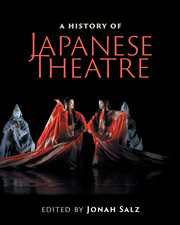Book contents
- Frontmatter
- Contents
- List of figures
- List of tables
- Contributors
- Contributors’ biographies
- Foreword
- Acknowledgments
- Note on Japanese terms
- List of abbreviations
- Timeline
- Editor's introduction
- I Traditional theatres
- Preface to Part I Japanese civilization arises
- II Modern theatres
- Preface to Part II
- III Arcs and patterns
- IV Theatre architecture
- Preface to Part IV Evolution of Japanese theatre architecture
- V Theatre criticism
- 19 Premodern practitioner principles: Zeami to Chikamatsu
- 20 Modern criticism: wrestling with Western realism
- 21 English language scholarship: a critical overview
- Interlude University scholarship and training
- VI Intercultural influences
- Epilogue: Frozen words and mythology
- Further reading
- Index
- References
19 - Premodern practitioner principles: Zeami to Chikamatsu
from V - Theatre criticism
Published online by Cambridge University Press: 05 July 2016
- Frontmatter
- Contents
- List of figures
- List of tables
- Contributors
- Contributors’ biographies
- Foreword
- Acknowledgments
- Note on Japanese terms
- List of abbreviations
- Timeline
- Editor's introduction
- I Traditional theatres
- Preface to Part I Japanese civilization arises
- II Modern theatres
- Preface to Part II
- III Arcs and patterns
- IV Theatre architecture
- Preface to Part IV Evolution of Japanese theatre architecture
- V Theatre criticism
- 19 Premodern practitioner principles: Zeami to Chikamatsu
- 20 Modern criticism: wrestling with Western realism
- 21 English language scholarship: a critical overview
- Interlude University scholarship and training
- VI Intercultural influences
- Epilogue: Frozen words and mythology
- Further reading
- Index
- References
Summary
Unlike in the West, where ever since Aristotle's Poetics drama has been central to discussions of literary history and theory, for most of their history Japan's theatrical arts were treated first and foremost as performance. Only in the Meiji period (1868–1912), when Japanese scholars began adopting Western typologies, did plays come to be considered examples of literature. Unsurprisingly, much premodern writing on theatre focuses on the context and features of stage presentation rather than texts. This discourse, moreover, was at first produced almost exclusively by performers themselves. Not until the Edo period (1603–1868) did there emerge a genre of theatre criticism by outsiders.
Noh: maintaining the flower and mystery
Critical and theoretical writing on the theatre can be said to begin with Zeami Motokiyo (1363?–1443?), often considered the founder of noh. Zeami did not so much found noh (then called sarugaku) as seek to ensure his own troupe's continuing advantage in a competitive performance world by codifying its successful practices. These had been developed under his father's (Kan'ami, 1333–84) and then Zeami's leadership, winning for their troupe, the Kanze-za, the patronage of shogun Yoshimitsu (1358–1408) and members of his court.
Zeami's thoughts on noh are found in a series of some twenty surviving texts. Fūshikaden (Teachings on style and the flower) was written in fragments between 1400 and 1418. Other texts followed in more regular succession, most produced while Zeami was in his late fifties or sixties. Often labeled “treatises” in English, these texts were not intended for the general public or even members of the profession as a whole, but rather written in the tradition of hiden (secret transmissions) established by religious or poetic lineages. Such confidences were intended only for chosen disciples or a particular son or relative succeeding as family head.
For Zeami, an important part of his family's legacy was the notion of hana (華 / 花 “flower” or “blossom”). This may be taken as a metaphor for the display of supreme artistry. The performer's ability to achieve such excellence was for Zeami the best guarantee of professional success. Attaining this level of accomplishment required mastery of fundamental skills, and for this reason Fūshikaden and many subsequent texts take up the issue of training.
- Type
- Chapter
- Information
- A History of Japanese Theatre , pp. 442 - 453Publisher: Cambridge University PressPrint publication year: 2016



